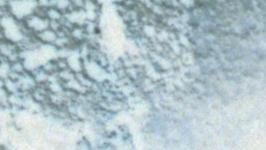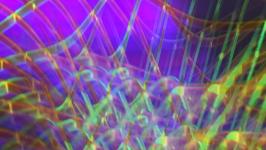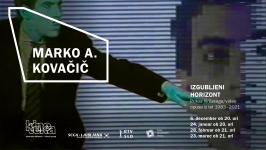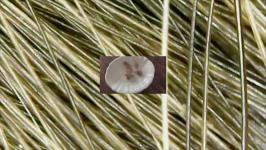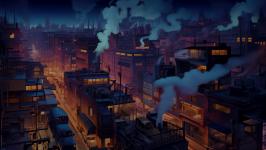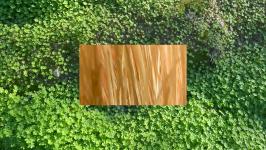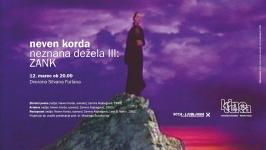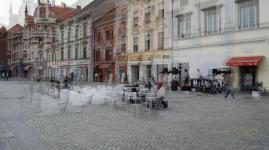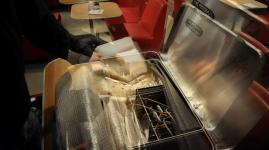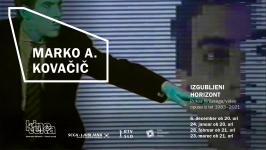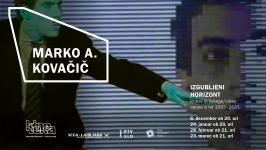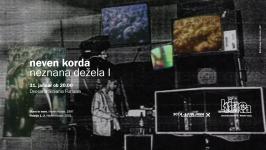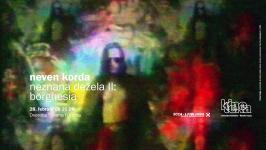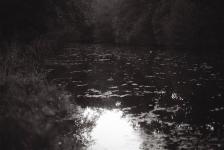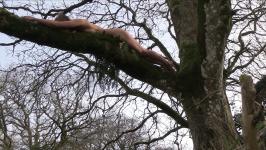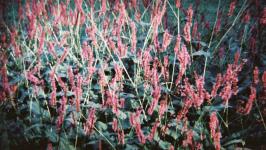Esej je bil podlaga za performativno predavanje Christopherja Krausa ob projekciji video del (25. april 2018, Projektna soba SCCA, Ljubljana). C. K. je takrat zaključeval podiplomski študij teatrologije na Inštitutu za uporabne teatrološke študije v Gießnu v Nemčiji. Na SCCA-Ljubljana je v aprilu opravljal enomesečno študijsko prakso – osredotočil pa se je na raziskovanje video in novomedijskega arhiva Postaja DIVA. Kot predmet svoje raziskave je izbral podobo in njeno medijsko prezentacijo. Raziskovanje arhiva je predavatelja vodilo v pripravo študijskega kuriranega izbora video del*, in sicer kot najdenih predmetov (objets trouvées) z namenom, da se razkrije pogled nanje skozi proces gledanja/opazovanja in tolmačenja, in ne toliko kot arhivskih ali muzejskih predmetov. Izbor, ki vključuje inserte iz izbranih video del, je služil kot gradivo za performativno predavanje. Več na SCCA straneh www.scca-ljubljana.si/christopher-krause-obraz-strukture
Faces and Structures
Christopher Krause
There is a quote from the German author Rainald Goetz who claimed that on TV there are only two kinds of images: Faces and Other.
And indeed, it belongs to the logic of televisual communication that there is always either a face on the screen, explaining the event that stays hidden. Or you see images of events: Objects, Landscapes, Structures...another kind of reality, masking those who watch and interpret it.
I would claim that the same goes for art: The artist hast to speak from the position of an expert to advertise his/her own work; or this work is dedicated to speak, mystically, for itself. In both ways, we follow some kind of shamanistic ritual to implement life and actuality into a certainly dead object.
The artist lends his/her voice to the object; the object lends its face to the artist.
What I want to explore in this lecture is the intertwinement between the artwork and the face that speaks for it. This gap indicates a fundamental split within the artwork itself (between the gaze that sees and that comes from the audience and the gaze that is transmitted back from the screen, seeing those who watch); but at the same time it points to a certain economy in the way how artworks are produced and for what reasons.
The gaze is in the image, as Jacques Lacan pointed out. The gaze is coming to us from the object as a kind of fascination: As another objet petit a that fills our imagination.
This split has been examined all the way down in art history with different strategies. What I want to do here is to address it in Slovene Video Art. As examples I chose videos that seem to fit in the widest, most different ways to that topic: Seeing and Being Seen.
This said, I can add that my starting point for that lies many years behind, when me and a friend where thinking about a Theatre Project, which would be based on a certain, well-known phenomenon: When you take a blank surface – a white cheat or whatever, you don't need much more than two dots to create a face.
In this way, there is nothing as easy as to find a face in any kind of given structure. Which also implies that almost every singular object can be attributed with some kind of persona.
Presented in this or that way, a structure can become charged with emotion, personality and meaning. You can sometimes see this in Animation techniques.
The most simple, logical, mathematical patterns, created by any kind of algorithm, can become a signifier that contains some knowledge in the outside world. They can be charged with metaphorical or metonymic sense, reaching beyond their so called presence: What they are.
Some examples:
[Here I show an examples video with images of Faces and Structures]
As you can see, the rhythm of exchange of the footage creates an interconnection of vague associations in which the images begin to communicate.
Not only are the positions of „Face“ and „Structure“ exchangeable.
But each of these two phenomena also immediately turns into the other at the same time. They are not one or the other, but always both.
This means that, connected via some rule or process, the images leave their status as objects which have meaning in themselves and instead become readable within the bigger set of a fiction or a kind of theory.
This is exactly the Logic of Algorithms, - the Logic of Google, that shapes our imaginary world today. The cultural theorist Boris Groys once claimed that Google has become what Philosophy and Religion once were: A machine for the liquidation of discourses and the autonomization of words from grammatical structure. A tool for creating similarity and egalitarity amongst everything. Its roots spread from Plato, to Structuralism and to Derrida … But another trace of this movement can also be seen in the autonomization of words in Avant-Garde movements: The creation of clouds of words without context. As a result of this radical emancipation of words, claims Groys, the social attitude towards knowledge today amounts to a fight about truth as such; about truth understood as the whole of all material existing contexts.
The position of a theorist today is confronted with the problem that his search for truth only adds up to the amount of parallel existing other truths. Also theory seems to become a curatorial practice, as this of selecting the footage of Google images for this small presentation you just saw.
So, if the world became totally self-similar with itself as a container for the variety of possible contents and contexts, what can this mean for a visual artist? What can this mean for running an archive? For curating? And for talking about artworks?
To be honest, I think not to be able to give a satisfying answer here. But I would point out that this is exactly the question all these practices have to confront with nowadays.
One way of dealing with it, could be to be as well as self-referential and to just talk about yourself. Or talking about what you are doing while just doing it.
So I think it's interesting to look at first on two examples of videos that deal with memory and fiction in the form of an artistic interview. The artist, so to say, here becomes identical with his/her own image. He appears the same time as witness and interpreter of his work as well as of his life.
The first example is from Dalibor Martinis, who did a video-interview with his 30-years-younger self.
[Dalibor Martinis – Martinis talks to Martinis: parts of it on
http://www.e-arhiv.org/diva/index.php?opt=work&id=1037 beginning at 00:30]
The recorded image is here messenger and interrogator at the same time. The image from the past asks the older TV-expert, whether he is still alive. Martinis has to face his own past-self that adresses him as the one who knows; the one who's in the position to interpret his past life and to bring this project to a conclusion.
But at the same time Martinis reveals that he is stuck in the fixed position of his own biography, which also limits his ways to look at his past. His interpretation is interpretation insofar it is limited through his own position to look at it. By that, his performance establishes a way of communication over time and reminds on the loss of information that is necessary for any act of communication.
More than a sentimental act of remembering, this performance is exactly about the opposite: The necessity of forgetting; which always comes before memory.
The other kind of artistic „fake“ interview is Miha Vipotnik's „Path of Crazy Wisdom“. This time it's not an interview the video-artist did with himself, but with the American sculptor Eric Orr.
The setup reminds on a kind of police-interrogation that circulates in references around Orr's work, in the way of a fictionalized crime story.
[Miha Vipotnik – Path of Crazy Wisdom
http://www.e-arhiv.org/diva/index.php?opt=work&id=215]
As you could see, Eric Orr is placed in this scenario as the circular point of a story about loss – the loss of a fictional character, called Johnny; which causes a lot of interrogating questions.
Orr, is known to have worked with materials like blood and bones and light and did a project called „Zero Mass“ that resulted in the creation of Sacred Places around the world. Now he is actually asked for the cause of all that.
An artist that is mostly dealing with the vanishing of things, with the creation of things about loss, is now asked to reveal his own myth - this pre-set, fictional Point „Zero“, the hole in the texture... or the objet petit a which absent presence makes us watch.
Eric Orr is put in the position of the keeper of his own secret. He's presented as witness of some event that we cannot know about.
Both persons in this video seem to play a game of inventing a story according to set rules.
This invention makes the art of Eric Orr something else. Instead of a series of objects that came out of a genius mind, they all become something else through re-interpretation. They become symptoms of a story that is created here and now between two people. By that this story creates also a net of links that exposes the connection between his work and his life within a new timeframe.
Instead of a case for art-historical research, the interrogation makes Eric Orr a myth, and on the other hand it makes his artworks to become hints to a speculative „lost cause“. (Like in Eric Orr's Biography, who has lost his father at fourteen years).
So in both interviews the artists expose themselves as an image and a voice which at the same time as it reveals, also hides something.
Now let's come to the more widespread ways in which one can approach Faces.
[Noemi Veberič Levovnik – FacesVoices
http://www.e-arhiv.org/diva/index.php?opt=work&id=1058]
What is this voice speaking? It seems to come from somewhere beyond, descending to earth in hallucination. Voice and image ultimately become an emblematic unit, which means a broken unity, whose only thing in common is the lack of trespass from image to word, from word to image.
Because it's some medieval setting, I immediately think about Dante:
When Dante encounters the souls in hell, he sees them as dark images which have nothing to do with their former appearance as a living person. He has to interrogate these images who they are. So Dante's interrogation in Divina Comedia has to reveal the broken relationship between appearance and being; in order to reconstruct the former unity, out of which to be fallen apart was the meaning of their sins in live and is now their literal punishment after death.
One can see this very well in the Dante's encounter with the nobleman who committed suicide and now appears as a black tree full of thorns. There is no obvious relation, no relation of similarity between the man and it's representation as an image in afterlife. Non-Similarity means here: There is really a break in existence. They are the same entities but at the same time they are not.
But this break in similarity makes Dante, on the other hand, participate in another kind of knowledge...the knowledge of detoured meaning: the knowledge of allegory. The tree, by that, has kind of a performative meaning: The break of similarity with their former appearance is a lateralization of the suicidal own sin, which was voluntarily negating his similarity with God by taking away his own body. That's why the suicidal souls will not awaken in their former bodies on Judgement Day, but they are condemned to dig their body out of the ground and hang it up on their tree, as a sign for their break of the eternal relation of similarity.
But also in other cases Dante never sees clearly who he has in front of him. He has to interrogate the image in order to find out whose identity it hides. The truth lies not on the surface of the visual appearance but in its confrontation with the explaining voice, that actually negates the image, as well as the image negates the identity of the one who tells the story of his life and death. Dante's interrogation brings us to the crossing-point of the logic of image to that of written language.
The heart-breaking story of the suicidal nobleman is in the same way summarized by the image of a dead tree, as it is annihilated by it in the undiscussable truth about what the result of his life really was about. The tree gets the status of a letter, of a title of law that is executed and typed on the punished soul. As absurd and a-logical this relation may appear, it's exactly by that why it's undiscussable. The appearance of truth always will have something absurd.
What Divina Comedia offers here can actually be seen as a very (post-) modern meditation about similarity and the independent, denotative power of signifiers.
Weeping, screaming, biting, doubting, … A Face can be charged with many different affects. And the more it gets affected: by the gaze of other faces, joy, disgust, comfort or the beams of the sun, … the more it can express and the more it expresses, the more it can mean.
Or it just stays without expression. Then it counts as the bearer of a truth behind its physical presence. What now follows are two documented performances that deal with the face, - or what I call face here – in interaction with some kind of physical body.
[Damijan Kracina – Nails http://www.e-arhiv.org/diva/index.php?opt=work&id=1]
An expressionless face can reach the status of what we call an icon - ...expressionlessness is actually what the term icon originally refers to. The icon doesn't look back at us. Its eyes seem just focused on some kind of truth that they face and that the image bears inside. Kracina redefines this plastic of his own face as some kind of fetish that can be charged with powers.
[Zmago Lenardic, Jasna Hribernik – Three Wishes
http://www.e-arhiv.org/diva/index.php?opt=work&id=228]
Also here we encounter the idea that a face, or the image of the face would bear some powers that can be released – through violence.
And every stain that stays from repeated smashing is looking back at us as a reminder.
As if the murder of your innocent rival would hunt you in your dreams by the appearing of the tree where you hung him up. Or somebody would just say „tree“ and you would know „This is the place where ...“
Or, I also assume it's for a reason that every time the body hits the table and becomes a little bit less of the creature it was before – I think it's no coincidence that we hear there an echo of the word „fish“ in the sentence „Grant me my wish!“. What we can observe is the execution of a total destruction of similarity.
In this way the performance is not a satire; not just a parody on the fairy-tale about the fisherman and his wife.
It is not laughing about the crazy man who smashes a dead fish on the table to grant him his wish. No, it takes this act very serious.
When you wish something so much that you type your wish with a bloodstain on a plate, or by planting a tree in your dreams to hang somebody up there, ...ever and ever again... than you will do it with the same constant effort with which universe responds „No“ to it.
I come to an important point: The big and more than obvious tradition between repetition and explicit violence.
That splatter films tend to repeat the most violent acts over and over again, speaks for their seriousness. Other than an expression of pervert pleasure, the repetition shows that the artists are ready to dig really deep into the serious, boring stuff. Explicity is a form of realism that draws a connection to the unsettling forces of human existence.
To work as a producer in the genre of drastic art, you really have to be confident to work on the surface. The lesson of drastic art is not a kind of vague critique on human existence, but to take the surface serious without looking for something that's hidden behind it. Superficiality is what takes the most of work.
[Andrej Lupinc – Screams and Shouts
http://www.e-arhiv.org/diva/index.php?opt=work&id=376]
You see here that cuts between images can create some kind of communication. We actually have some kind of dialogue, some kind of affection going on here: Between the knife, and the screaming mouth, between the mouth and the head of the shower, between the falling knife and the blood...
Those things form a kind of grammar amongst each other that is charged with affectation.
Their interconnection through the rhythm of video editing creates an autonomous crossover of time-space and memory – a kind of internal movement that shapes the experience of these videos.
I want to emphasize on the point that behind these kind of scenes lies very hard work of dealing with details; of technical knowledge about tension, release and expectation...Things that we normally tend to mystify, are solved here, in this fictional setup in a very concentrated, sober, technical way...It's a certain kind of realism.
Insofar as drastic themes are superficial, they always deal with the destruction of the face. What is left from those festivities of violence is a boring structure, an abstract plane scale of coordinates to orientate:
This was a nose, these were the eyes, this was a mouth that was speaking for this and that truth. Or: This was a temple, and here we have the marketplace, and the ruins of an old palace … Even if you can not see it... Archaeology is especially about this experience of an imaginary lost place by reading some meaningless stones as sign for something that they obviously aren't anymore. The truth is not at all achieved through some physical evidence, but by creating a fiction, that allows you to create another imaginary through which you perceive reality.
[Gorazd Krnc – Five AM, Light
http://www.e-arhiv.org/diva/index.php?opt=work&id=574]
This was one of the music videos I really liked that I found during the research.
What inspired me here is the idea that all the good stuff I want to talk about, you can find in Popculture.
Nevertheless, this scenario looks also far from today. This attitude of celebrating music, of joy, ecstasy was different in the beginning 2000's when the video was made.
Insofar it's commercialised, Techno Music today lost its utopia and what stayed from it was the idea of pure hedonism and in the best case a kind of negative affirmation towards those contradictions that itself belongs to. What's lost is the sense for the explicty and brutality that Techno might have had in its beginning in the 80's. But it's still a machine that can evoke a variety of affects and the more it seems appropriate to praise this video for this relaxing, non-exhausting lesson in beauty.
One can say Pop culture and Arts went on very similar ways over the last years and about both you can ask the question in what ways they really still do exist today.
Going on with complaint:
[Neven Korda – 1 Sec of My Life
http://www.e-arhiv.org/diva/index.php?opt=work&id=763]
Here we are, at the point where all flesh is vanished. We came back to the modern destruction of objectivity. The sadness of a plain field. And behind a monochrome veil there is of course the artist, reading from his diary:
„When, in the year 1913, in my desperate attempt to free art from the ballast of objectivity, I took refuge in the square form and exhibited a picture which consisted of nothing more than a black square on a white field. The critics and, along with them, the public sighed, 'Everything which we loved was lost. We are in a desert.. .Before us is nothing but a black square on a white background!' But the desert is filled with the spirit of non-objective feeling.. ..which penetrates everything.“
Kasimir Malevich
Paul Klee 1914 in Tunis: „Colour has taken possession of me; no longer do I have to chase after it, I know that it has hold of me forever.. .Colour and I are one. I am a painter.“ Paul Klee
What I explained in the beginning about the autonomization of words in modern art, goes as well for colours. 20's century artists where interested a lot in monochrome surfaces, before TV images could make the world look completely like this:
[Marko Peljhan – The Park of Culture (TV situation)
http://www.e-arhiv.org/diva/index.php?opt=work&id=84]
Fascination about anonymous, indescribably, ghostly processes. Deep fascination also about dead objects, the hidden life of a technology that we don't understand.
The world runs slow, is almost not moving, but there is always the tension of alert, of ongoing events. What for Peljhan probably was a reflection about a certain archetype of TV-images from life reportages and News channels, is today more than ever the fundamental experience of the real world. Everything is observable and reality is more then ever expressed in the way of statistic measurement about everything and everybody. For good reason! But this hysteric attitude towards knowledge also implies one thing: that the whole of creation is condemned to terminate and is silently craving its way to catastrophe.
What has changed in our perception of the world today is, that we are suspicious, that end is not in front of of us, but already behind and still going on. So the images of those lonely icebergs and slow submarines and diving whales, seem to refer as emblems to the ongoing constant complaint of nature about existence itself. The running subtitle waves like a praying flag under these invisible microscopic processes that we can not control. We are desiring to look at a world without human beings, a world that is already beyond us.
Another example for this kind of fascination:
[Elena Fajt; Luka Dekleva – The Memory
http://www.e-arhiv.org/diva/index.php?opt=work&id=862]
What looks like an organic structure, spreads like a deadly mass that is threatening. Looking at those videos you can see that the absence of human beings can become threatening exactly because we personalize the dead or automatized objects. We are confronted by them because we encounter faces in them. Or maybe it is the other way around and faces are just the result of something that confronts our very existence in one or the other way.
Now I come to two more quiet, very structuralist examples where you can see the emergence of Faces from types and inter-punctuation marks. We can see a mouth, ears, blinking eyes,.... a tongue made from letters, ... Actually very classic.
[Alenka Pirman – Franci Zagoričnik - Črno-beli diapazon, 1966-2006
http://www.e-arhiv.org/diva/index.php?opt=work&id=944 ]
[Alenka Pirman – Ales Kermavner - KAJ JE (V-SEBI-NA = V), ok. 1966-2006
http://www.e-arhiv.org/diva/index.php?opt=work&id=947]
Now something very funny:
[Bostjan Kavčič – Made in Venice: http://www.e-arhiv.org/diva/index.php?opt=work&id=678]
I would call this the idea „to write on an existing face“. To use an existing structure to make it shout in the name of the artist „I“.
Also you can find here the opposite of this pessimistic view on nature that I just developed a few minutes ago. Here it's a chaotic living mass – the pigeons- that is affected by some food. And in this way it's structured and mechanised to do its job as a typewriter.
And the last one:
[Miha Vipotnik – Laughter: http://www.e-arhiv.org/diva/index.php?opt=work&id=1198]
We have here the militaristic image as the clearest overlap of these three: The graphical simulation of a strategical terrain, the order of the letter that is typed on this simulation, as an abstract frame, that provides an additional 'command' – the command of the symbolic order.
And: the face that is emerging in the crossover of these other two. It is looking at you unreducible with the gaze of a hidden knowledge. We might know this view from strategic Computer Games where you also have this view from above. You see the terrain that you have to explore and control, and on the outskirts you have the black areas – the fog of war, which is the area you don't know about. Let's say your strategical unconscious.
And here this letter „Y“ popping up in the middle of the screen. This is something extra. As well is the white dots, moving on the opposite side and the black spot that also seems to mark the position of something hidden.
One can argue, that these points are probably signifying traces of some surplus-intervention; that means they are traces of something that works on this screen, beyond the machinic algorithm that makes it „work“. Like the mouse-arrow with which you control your units, smash the enemy and dominate the area. This whole arrangement here is a good example of an interface. And like every good interface it has some extra objects, representing our engagement within the simulation.
The mouse-arrow is a point of cross-over between two realties within an interface. By that it makes us „work“ within the simulation and gives us a kind of surplus enjoyment, because it's the representation of us, of the subject in the game.
But of course this arrangement hides something, namely the faces of those who it strategically identifies as targets. This plain coldness serves as strategical mask to make war operational, to mask the act of killing in order to make it „workable“. This is the perversion of interfaces, which as we could see in all these examples I gave here it can not deny. In its permanent twist between revealing and hiding, between face and structure, the interface might show or hide as well as it can, but it will never be able to hide that it does both at the same time. The interface reveals that it is always a veil, through which we perceive reality. It is the fabrication of the veil that contains information about its intentions. So the most political thing one can do with fabricated images is to gain literacy in reading them, as you would read the newspaper.
Another remark: Interestingly enough, the letter you can see popping up here in Vipotnik's video here is the „Y“. It bears not only some similarity to the iconic cross, but also to the tree, that we just mentioned some times in our talk. And it is of course also the icon of a tree that for Saussure signifies the signified itself.
As you can see, paranoia will not stop, the sliding of the signifier will not come to an end and it will not allow any work of art to close in itself. So there is a lot to do for somebody who wants talks about it.

